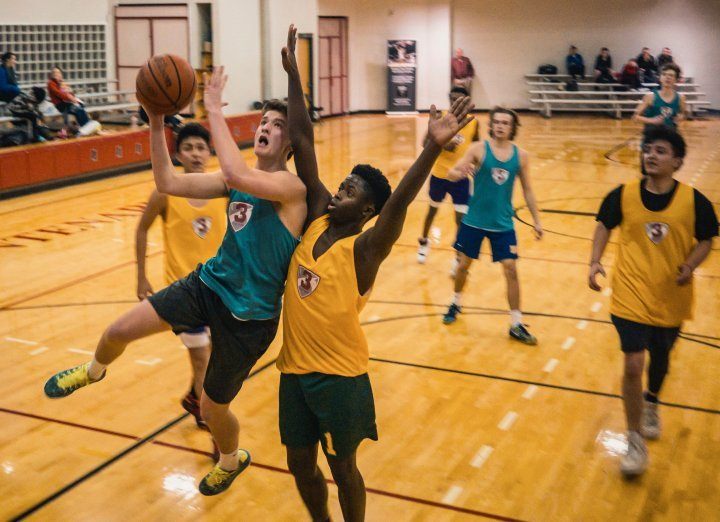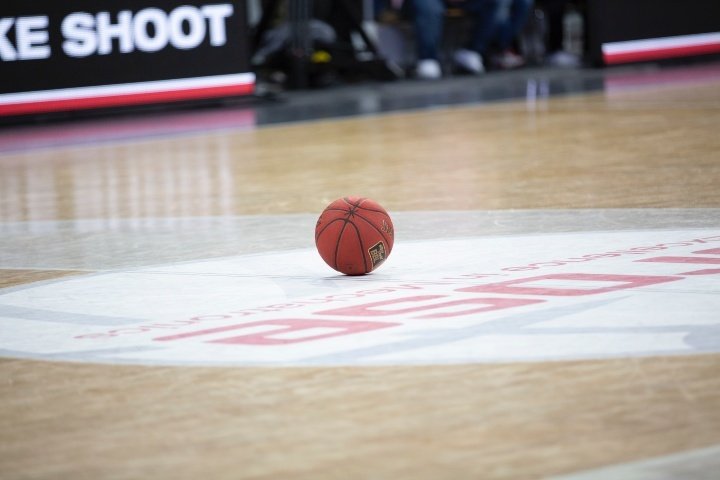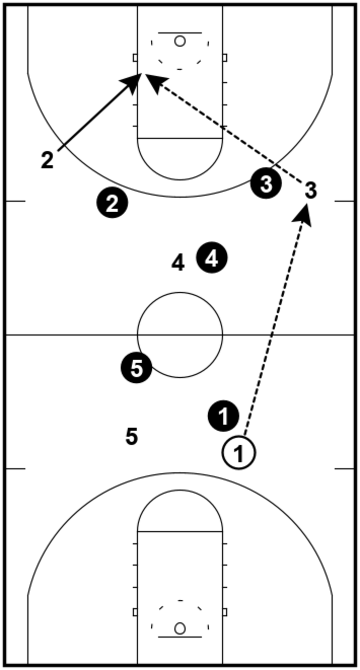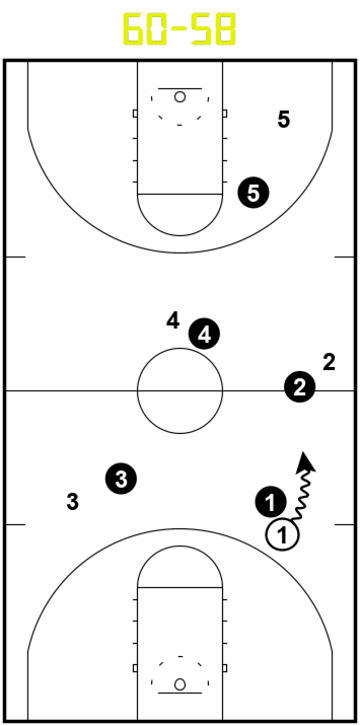
A great basketball practice has several key elements.
Coaches must find the right combination of skill development drills, team drills, and small-sided games. And no good practice isn’t complete without some 5-on-5 basketball scrimmage time.
We don’t need to complicate it:
Players benefit from playing the game.
Some coaches don’t embrace scrimmages because they view it as simply “rolling the ball out.”
But when done correctly, this couldn’t be further from the truth.
With an intentional plan, there are many ways to maximize basketball scrimmages to help your players and team develop.
What is a Basketball Scrimmage?
Let’s begin by defining what scrimmage time is.
Basketball scrimmages are simply 5-on-5 full court games during practice.
These games could be unstructured, or the coach could expect the players to execute the team’s offensive and defensive systems.
While some coaches want few stoppages during this time, others will blow the whistle frequently to make corrections.

13 Basketball Scrimmage Ideas
1. Always Keep Score and Run the Clock
The competitiveness of your players will increase when they know you are keeping score.
Use the scoreboard in your gym if possible.
If not, you could even have players shout the score after each made basket.
Using the clock helps players develop situational awareness. A good shot with 5 minutes left may be different than a good shot with 45 seconds left, and this is important for players to learn.
Having the losing team suffer a short consequence – one quick sprint or 10 pushups – raises the stakes even more.
2. Keep Games Short
It’s far better for players to go hard for a shorter time frame than to trudge their way through an hour-long scrimmage.
I like to scrimmage in 4-minute intervals.
After this time, we may take a short break, do a shooting drill, or reflect on strengths and weaknesses of the scrimmage session before beginning another 4-minute game.
Think about it...
In a game, there is rarely non-stop action for more than 3 - 4 minutes at a time.
Another benefit of short games is they make it easier to substitute.
I hate having subs standing on the sidelines for long stretches.
If a player sits for the first 4 minutes, he or she will always play the next session.
3. Incorporate Validation
This is a simple concept that I first heard from Coach Vance Walberg.
He incorporates “validation” into all competitive drills or games.
The team that wins the scrimmage has to validate the win by making a free throw.
This can work one of two ways:
Option #1 - Continue playing if the free throw shooter misses. The other team would now have an opportunity to take the lead and validate it with a free throw of their own.
Option #2 - Both teams complete the consequence on a miss. This is a great way to incorporate some pressure free throw shooting into your scrimmage time. Coaches will get to see who they want shooting foul shots at the end of close games.
4. Use Different Starting Points
This is a great way to ensure your team is focusing on some specific situations while still letting them play up and down.
Start the scrimmage with a specific starting point. This could be a baseline inbound play, a sideline inbound play, a free throw, or a press attack.
The coach controls when to start with that situation again.
You could specify a specific number of trips down the floor to reset, you could reset after each made basket, or you could let them play until you blow the whistle.
I typically recommend 3 trips of the floor:
Team A starts with an inbound play. They play to the remainder of the possession, make or miss. Team B will then push the other direction and play an offensive possession. Finally, Team A transitions back for one more offensive possession.
After that, switch roles, with Team B beginning the action with an inbound play of their own.
This keeps games shorts, allows for easy substitutions, and teaches players to value each possession.
5. Consider How to Call Fouls
It is the coach’s job to determine how to officiate scrimmage sessions.
There are several factors to consider here:
If you have a team that lacks physicality...
It might be a good idea to only call the most obvious fouls and let the players play through some contact. This could “toughen up” your players and make them more physical on both ends of the floor. Calling fewer fouls also helps maintain the flow of the scrimmage because there will be fewer stoppages.
If you have a team that fouls too much...
You may want to be stricter with the whistle. While I love having a physical team, I certainly don’t want my players entering our first game without a realistic understanding of the rules.
6. 4 Second Bonus
To get players playing fast in transition while still getting quality shots, consider giving them extra points for pushing the ball quickly down the court.
Here’s how:
Play a regular basketball scrimmage of 5-on-5 with regular scoring rules.
However, an extra point is awarded to a team every time the offense gets the ball below the opposite foul line within 4 seconds of gaining possession.
To implement this rule, you need to find a coach or parent who will count down from 4 on every change of possession.
This game encourages players to sprint on every possession, pass the ball down the floor instead of dribble, and promotes unselfishness.
If you’re coaching a younger group, feel free to increase the time to 6 seconds.

7. Change Defenses
Another way to focus your scrimmage sessions is to let each team continually change which defense they’re playing.
For example, your team might run half court man, a 1-3-1 zone, and a 2-2-1 press.
Each team can huddle before the scrimmage to develop hand signals or special calls for each defense, so that they can switch it up on each possession.
This is a fun variation to a traditional basketball scrimmage because it forces both teams to think and recognize what defense the other team is in.
In a real game, a coach can’t call timeout every time the other team does something different, which is why players must learn to read the defense and adjust on the fly.
8. Give Your “B” Team an Advantage
One challenge of practice scrimmages is how to divide your players.
Each strategy has its own pros and cons.
At the HS level, some coaches prefer creating even practice teams, while others like to keep their starting five or varsity team together.
If there is a talent disparity between your two teams, you may want to give the weaker team an advantage to keep the scrimmage competitive and to further challenge your starting group.
Two ideas:
a. Give the B Team a Head Start
If you’re playing first to 20 points or something similar, start the game with the B team already on 8 points. This advantage gives both teams a good shot at winning.
b. Allow the B Team to Earn Points in Other Ways
You could award points to the B Team for things like paint touches, offensive rebounds, or forced turnovers. This gives them a chance to win, and can be used to force your starters to focus on a particular area of the game.
9. Emphasize “Game Changers”
This is a fun scrimmage variation you could use occasionally…
If there are certain “momentum plays” you value, tell both teams that if they achieve one of them, they automatically win.
An example:
Tell your players that if someone takes a charge, their team automatically wins.
If it’s the final scrimmage of the day, you could even tell them that practice will end immediately once it happens (after the losing team completes its consequence).
You wouldn’t believe how much motivation increases if players think they can earn a little extra rest for the entire team.
In the book “The Old Man In The Gym”, Coach Bob Taylor promotes a similar strategy with 6-0 runs, believing that 6-0 runs have a major impact on winning games.
You may be playing a 4-minute scrimmage, but it will automatically end if one team scores 6 consecutive points.
This is a great way of emphasizing capturing and maintaining momentum during a game.
10. Film Your Scrimmages
I strongly urge coaches to film their practice scrimmages.
Even the most observant coach is sure to miss some important details while watching live play.
Film lets you go back and look for small details both offensively and defensively.
It can also be a great teaching tool if you choose to share it with your players.
Basketball Scrimmage Drills:
1. Quick Strike
How the Drill Works:
Teams scrimmage with each having only 15 seconds on the shot clock each possession. The offense is rewarded for a quick score based on the time left on the shot clock. For example, if they score with 10 seconds left on the clock, they are awarded 10 points.
Purpose:
This drill helps teach the team to push the ball up the court quickly, to immediately look for scoring opportunities, and to play lightning fast basketball.
Setup:
- Set up two teams of five players, preferably with matching color jerseys for each team.
- You’ll need a shot clock for this drill, and a shot clock operator.
- In case you cannot use a shot clock, a coach or an assistant can use a stopwatch and count down the time left on the clock.
Instructions:

1. The drill starts with a jump ball, and the teams play live 5-on-5 full-court game.
2. The team in possession has only 15 seconds to shoot the basketball, and the shot clock operator (or a coach) restarts the shot clock (or a stopwatch) as soon as there is a change of possession.
3. A shot clock (or a stopwatch) is used by the same basic rules as in any game where a shot clock is used – it gets restarted after a foul, a turnover, a made basket, and after the basketball touches the rim.
4. When an offensive team scores, they get awarded a number of points equal to the time left on the clock. For example, if they score after 5 seconds and there are 10 seconds left on the clock, they are awarded 10 points. But, if they score with only 2 seconds left on the clock, they only get 2 points.
5. If a team fails to shoot within a 15-second period, a shot clock violation is called and the basketball changes possession.
6. The game lasts for a set period of time, and the team with the most points in the end wins.
Variations:
Shot Clock Variations:
Depending on the age of the players and their abilities, you can adjust the time and vary the time available on the shot clock (for example, 12 for advanced players, 18-20 for younger teams).
4-on-4:
Instead of playing 5-on-5, you can set up a game with two teams of four players, or even a 3-on-3 game, for example, in case you have a smaller group of players.
Slow Strike:
In this game the scoring system is inverted:
The offense is awarded based on how much time they took off the clock.
25-30 seconds shot clock is recommended for this variation, and if the offense scores with only 3 seconds left on the lock, after 27 seconds (out of 30, for example), they get 27 points. But if they score after 5 seconds, they will get 5 points.
This is especially useful when you’d want to work on late-game situations - when you’re trying to delay the offense.
Coaching Points:
Find Good Shots:
Although they’ll quickly realize this during the game, explain to the players that they need to try and find good shots throughout the game.
Even though the game rewards quick scores, they still need to score to get points.
If they force bad shots and keep firing the ball up towards the basket from too far away, they won’t have much chance of earning any points for their team.
Good Outlet Passes:
Emphasize the importance of looking for an outlet pass immediately after a defensive rebound or a turnover, and then pushing the basketball up the floor quickly preferably using a pass.
2. 56 - 56 Scrimmage
How the Drill Works:
Teams scrimmage with 56-56 score. When either of two teams reaches 60, the clock starts. They have 2 minutes on the clock, and both teams try to win the game.
Purpose:
Great drill for practicing late-game situations with your team.
It simulates these situations and puts the players into a real close game scenario, with the pressure of winning the game for both the leading and the losing team.
Setup:
- Set up two teams of five players, preferably with matching color jerseys for each team.
- You’ll need a scoreboard and a scoreboard operator. In case you cannot use a scoreboard, a coach or an assistant can track the score and time left (using a stopwatch or phone).
Instructions:

1. Set the score on the scoreboard to a tie score - for example, 56-56. For the start, don’t put any time on the scoreboard.
2. The game starts with a jump ball, and the teams play live 5-on-5 full-court game.
3. When either of the teams reaches 60, set the time to 2 minutes left on the clock.
4. Both teams try to win the game with what they have – being either down 4 points, or 1, for example, or up 4 points.
5. Naturally, the losing team will probably try to play aggressive defense and look to score quickly on offense, while the winning team will try to maintain the lead and perhaps slow down the offense, trying to find good shots.
6. Teams play until the end of the game, and the team with the most points wins.
Variations:
Teams Win When They Reach the Target Score:
Instead of starting the clock when a team reaches 60, make the the end goal of the drill.
Coaching Points:
Coaches Assigned a Team:
If you have an assistant coach, each of you can be assigned a team.
If you have two assistants, each of them can be assigned a team, so that they could also practice late-game situations and develop their coaching skills, while you can focus more on evaluating how your team (and each of the players) handles late-game situations.
Late-Game Details:
You can upgrade the scrimmage by deciding on other late-game details, such as timeouts left for each team, team fouls, player fouls, etc.
Talk It Out Post-Game:
After the scrimmage, share your thoughts with the team, what was good, what worked, and on the other hand, what should be improved.
Conclusion
There are many ways for coaches to maximize the productivity of scrimmage sessions.
These are just a few strategies and game ideas.
Consider your own team and the purpose you have for a specific practice.
By being creative, you can ensure the basketball scrimmage session fits the needs of your team and makes your players better.
